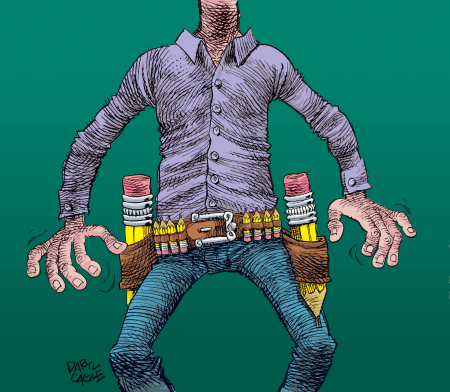Tempers run short in turbulent times, so it is no surprise that provocative editorial cartoons sometimes get blowback from readers. Cartoons generate angry conversation on social media, but they seldom generate complaints to us, or to the newspapers that run them – unless there is an organized campaign to solicit complaints. These campaigns usually take the form of Facebook pages that demand that an editor or cartoonist is punished, or simply demands an apology, and newspapers are often quick to apologize.
Sometimes editors blame their choices on poor editorial cartoons in general, as when the New York Times dumped the little Cartoonists & Writers Syndicate that they hosted and announced that they would stop running editorial cartoons entirely in all of their editions. One of our CagleCartoonists, Patrick Chappatte, lost his regular gig for the International New York Times with this editorial overreaction, over a cartoon that Patrick didn’t draw.
Back in July of 2016, a complaint campaign against the St Louis Post-Dispatch targeted this Dave Granlund “itchy trigger-finger” cartoon and elicited a typical apology from the editor.

This week there was a similar campaign of complaints and demands about the “Bad Cops Under the Bed” cartoon of mine that ran in the St Louis Post-Dispatch, but this time the newspaper, to their credit, didn’t apologize and stood behind me and the cartoon in an editorial.


Earlier this month there was yet another complaint campaign about a Gary McCoy cartoon in the Florence SC Morning News. This longtime CagleCartoons subscribing paper prints just about every cartoon that opposes abortion rights and there aren’t a whole lot of those, so when one pops up it is no surprise that it gets ink in Florence. The abortion topic doesn’t mix well with Black Lives Matter (I thought the cartoon was offensive myself) and the paper apologized, going the New York Times route of announcing that they are no longer running any editorial cartoons at all. They still like our columnist Michael Reagan though, so they continue to be a good subscriber and we hope to woo them back with more, great conservative cartoons. (Those anti-abortion cartoons are pretty hard to resist in Florence.)
Also earlier this month, our CagleCartoonist Rick McKee suffered a complaint campaign with this cartoon in The Columbian newspaper in Washington. The newspaper took the usual route of apologizing for the cartoon, but didn’t ban all cartoons.

There are more recent examples with cartoons from cartoonists who aren’t represented by my little syndicate generating complaints campaigns and newspaper apologies, but I’m not posting them here because, well, they aren’t represented by my little syndicate.
This is the new normal:
1. A reader is offended by a cartoon she disagrees with in her local newspaper and puts up a Facebook campaign soliciting complaints demanding an apology, the firing of the editor and/or the firing of the cartoonist.
2. The Newspaper apologizes for their poor choice of cartoon; or they stop running all cartoons. No other newspapers get complaints about the cartoon, only the one paper that has a campaigning reader gets complaints.
3. Repeat.
It was nice to see the St Louis Post-Dispatch break that pattern this week, standing by my cartoon. Editors should have the guts to stand behind their decisions.


















